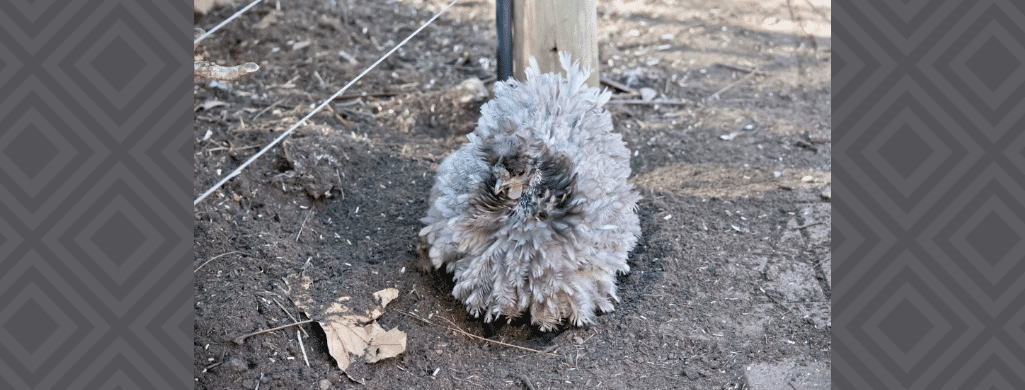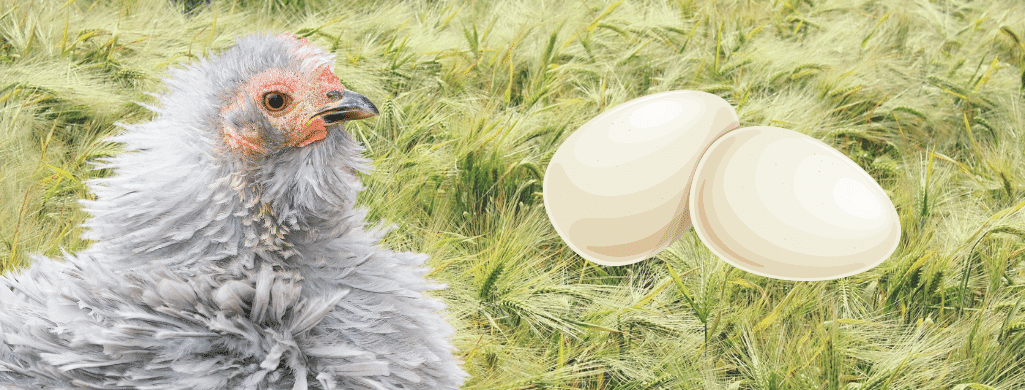Frizzle chicken breeds make unusual-looking birds that come in an array of colors.
This makes them excellent show birds. But they have a lot more to offer!
So, when do Frizzle chickens start laying eggs? Are they good layers?
Frizzles start laying around the same age as other chickens, between 5-6 months. If they come of age in the winter, they usually wait until spring to lay their first egg. Egg production and precise timing change based on what breed of Frizzle chicken you get.

Table of Contents
ToggleWhat Age Do Frizzle Chickens Lay?
A Frizzled Pekin may come into lay sooner or later than a Frizzled Polish chicken.
Because Frizzles are a group of many chicken breeds, it’s even harder than usual to tell you exactly when they’ll start to lay.
But it’s pretty safe to say they will start laying by 6 months of age.
This puts Frizzles at the later end of the laying spectrum. They won’t be far behind your other pullets, though.
If you raise bantams, your Frizzles will likely be in line with the rest of your flock.
Of course, there are many reasons your birds might start a little late:
- Poor nutrition
- Cold climate
- Health issues
These obstacles are present across all breeds of chickens, so you’ve likely dealt with them before.
Pay attention to protein and calcium content when you choose a layer feed. Your birds need a balanced diet of chicken pellets and foraged foods.
Frizzles are vulnerable to the cold, so don’t expect them to be miraculous winter layers.
If they are especially late in laying, don’t be afraid to get them checked over by a vet.
Health issues are often way more dangerous if you leave them untreated.
If nothing’s wrong, you at least get some peace of mind!

Are Frizzle Chickens Good Layers?
When we look at different breed types, Frizzle chickens have huge differences in egg production.
A Cochin Frizzle, for example, lays less than 130 eggs per year. Meanwhile, Plymouth Rock Frizzles lay more around 150 eggs per year.
The frizzle gene has a huge impact on the breed’s appearance. But from breed to breed, egg production does change.
Similarly, a Frizzled Silkie is still likelier to be an attentive mother hen than a Frizzled Pekin.
Generally speaking, though, Frizzle chickens are docile birds and do well with baby chicks.
Egg production among different breeds of Frizzles ranges from 100-150 eggs per year.
Even though they’re beautiful birds, Frizzles are not nearly as productive as their non-frizzled counterparts.
A Plymouth Rock Frizzle lays only 150 eggs yearly, for example, while a standard Plymouth Rock can lay more than 200 eggs yearly.
Getting Frizzles is a bit like getting Bantams: You make sacrifices in production for benefits in size or appearance.
Frizzle hens still make good dual-purpose birds and strong contenders for chicken competitions.
Further Reading: Can you eat Silkie chicken eggs?
What Makes Frizzle Chickens Unique?
Frizzle chickens have the frizzle gene, which gives them adorable curled feathers.
The frizzle gene is relatively harmless and mostly changes the appearance of a given breed of chicken.
However, if two Frizzles are bred together, the results are often disastrous.
The offspring of two Frizzle birds is called a Frazzle, and they rarely live longer than a few months.
Having two copies of the frizzle gene causes serious health issues. For example, some chickens with this mutation will be born with an enlarged heart.
If you use a broody Frizzle hen to hatch some chicks, do NOT breed her with a frizzled rooster.
Those future baby chickens will live much longer, and everyone involved will be much happier in the long run.

Challenges to Frizzled Layers
We talked before about how the winter months make laying difficult for Frizzles.
The truth is, winter is hard on Frizzle birds in more ways than one.
Your standard feathered chicken can keep a regular constant body temperature. Frizzle chickens have a much harder time with this.
How their feathers curl away from their body is bad for maintaining their body heat.
Your chicken coop needs to be a nice, warm safe haven from the cold of winter.
To keep the coop toasty warm for your birds, here’s what we recommend:
- Get a heater
- Cover windows and holes
- Lots of bedding
These are small gestures your chickens will appreciate.
Growing up in New England, I saw many chickens get frostbite or otherwise suffer in the cold.
We covered our coop windows every fall and even patched holes where rodents had forced their way in.
Even these steps weren’t always enough to protect our birdies, though.
My mother always used heat lamps like this one on Amazon, which is definitely an option if you’re tight on money. Just keep an eye on the temperature as they tend to get really hot.
If you’re looking for a good safe heater for your coop, I like this one on Amazon. It was designed with chickens in mind, and many chicken owners have had good experiences with it.
In fact, some users say it takes more than one to really heat up a coop. This is a safer alternative, though, to heat lamps.
A good rule of thumb with any chicken coop heater is: If it burns your hand, it’s too hot!
To ensure your heater is doing the most, cover up those coop windows.
When the shed is poorly insulated, the heat disperses into the cold and doesn’t protect your chickens.
Lastly, bed your birds generously when it’s cold outside.
Frizzles Aren’t Just for Show
Frizzle chickens start laying around 6 months of age.
They tend to lay fewer than 150 eggs yearly, but their precise egg production depends on the Frizzle breeds you raise.
Because of their curled feathers, Frizzle birds lay poorly in the winter. They also need extra protection from the cold, as our article here will tell you more about.
How useful was this post?
Click on a star to rate it!
We are sorry that this post was not useful for you!
Let us improve this post!
Tell us how we can improve this post?
